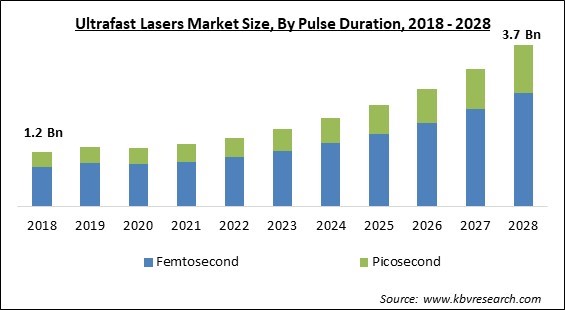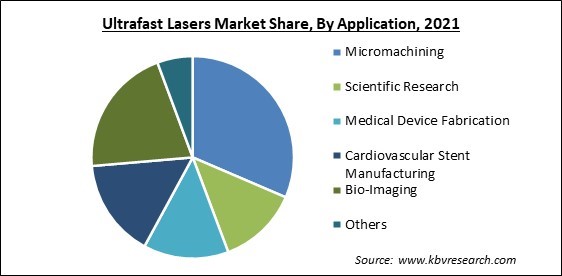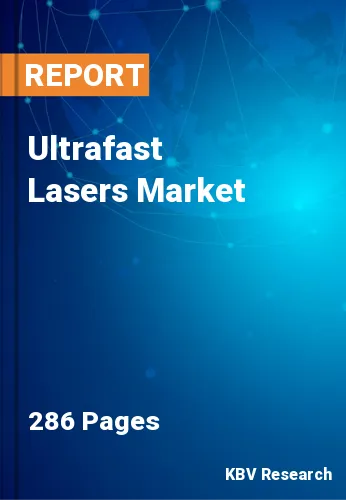The Global Ultrafast Lasers Market size is expected to reach $3.7 billion by 2028, rising at a market growth of 15.3% CAGR during the forecast period.
spectroscopic method called ultrafast laser spectroscopy uses ultrashort pulse lasers to analyze dynamics on very short time scales (attoseconds to nanoseconds). The behavior of charge carriers, atoms, and molecules is studied using various techniques. There are several aspects of the laser pulse that must be understood to perform reliable spectroscopic measurements, including pulse duration, pulse energy, spectral phase, and spectral shape.

Through measurements of autocorrelation or cross-correlation with another pulse that has been thoroughly characterized, information regarding pulse duration can be obtained. Frequency-resolved optical gating (FROG) and spectrum phase interferometry for direct electric-field reconstruction are two techniques that allow for a thorough analysis of pulses (SPIDER). The goal of pulse shaping is to precisely alter the pulses coming from the source, including their amplitude, phase, and length.
To increase the intensity of a pulse, chirped pulse amplification which consists of a pulse stretcher, amplifier, and compressor is typically used. During the amplification, it won't alter the pulse's duration or phase. By initially chirping the pulse in a nonlinear material and broadening the spectrum, pulse compression (shortening the pulse length) is made possible.
A compressor is then used to compensate for the chirp. In this situation, a fiber compressor is typically utilized. Optical modulators that subject a laser beam to Fourier transformations are referred to as pulse shapers. Modulators are also known as intensity modulators, phase modulators, polarization modulators, and spatial light modulators depending on which aspect of light is regulated.
Optical modulators are classified as Acoustic-optic modulators, Liquid crystal modulators, Electro-optic modulators, etc. depending on the modulation method. Each is devoted to a separate set of uses. By ionizing and collisional an electron, high harmonic generation (HHG), a nonlinear process, transforms intense laser energy from one single frequency to high harmonics of that frequency.
The introduction of numerous rules has also caused consumers to reduce their demand, which is disrupting the market for ultrafast lasers' potential revenue as well as its supply chain. To promote the widespread use of ultrafast laser market trends, the government and the major market players are working together and investing in research and development. Additionally, businesses are expressing an interest in mergers and acquisitions that will boost their market share and contribute to the ultrafast laser market's expected growth throughout the current forecast period.
The need for a small, dependable electronic device was created by technological advancements in consumer electronics, computers, networking and telecom, transportation, healthcare, and consumer electronics. Such portable electronic devices demand great dimensional accuracy for components like displays. It is projected that there would be a rise in demand for the fabrication materials required to make high-performance semiconductor components. In high-speed, completely integrated applications like aerospace and some consumer electronics, the demand for compact equipment has expanded dramatically.
Numerous industries are undoubtedly impacted by the COVID-19 pandemic, but if things return to normal, it is anticipated that the economy will recoup. For instance, there will be a considerable change in the automotive industry toward electric vehicles (EVs), which will lead to a demand for ultrafast laser systems. Both the consumer electronics industry and the medical industry are seeing a similar trend. Many sectors are adopting ultrafast lasers due to their many benefits.
The market for ultrafast lasers is growing because of the need for increased dimensional accuracy and government policies that support them, but other issues, such as manufacturing challenges, are anticipated to limit the market growth. Handling these systems in an industrial setting needs technical proficiency due to their technological complexity, nonlinear effects during beam propagation, and interaction process. Therefore, despite the numerous benefits this technology claims to offer, it is commonly criticized for being delicate, expensive, and slow, which makes it difficult to implement into production processes.

Based on the Type, the Ultrafast Lasers Market is divided into Titanium-Sapphire Lasers, Fiber Lasers, Mode-Locked Lasers, and Others. The fiber lasers segment acquired the highest revenue share in the ultrafast lasers market in 2021. It is because, for a variety of industrial manufacturing operations, such as welding, cutting, and additive manufacturing, fiber lasers are versatile and potent instruments. Due to the numerous healthcare systems that are using ultrafast fiber laser technology, the market for medical laser systems is expanding.
On the basis of Pulse Duration, the Ultrafast Lasers Market is segmented into Picosecond and Femtosecond. The femtosecond segment procured the largest revenue share in the ultrafast lasers market in 2021. It is because these lasers are being used more frequently in the field of portable electronics. Mobile phones, microprocessors, memory chips, and display panels are some examples of extremely complicated components.
By Application, the Ultrafast Lasers Market is classified into Micromachining, Bio-Imaging, Scientific Research, Medical Device Fabrication, Cardiovascular Stent Manufacturing, and Others. The bio-imaging segment registered a significant revenue share in the ultrafast lasers market in 2021. Bioimaging refers to techniques that allow non-invasive real-time visualization of biological processes. The goal of bioimaging is to interfere with biological processes as little as possible. Additionally, it is frequently used to learn about the 3-D structure of the viewed specimen without physical disturbance.
Based on the End-User, the Ultrafast Laser Market is bifurcated into Consumer Electronics, Medical, Automotive, Aerospace & Defense, Industrial, and Others. The consumer electronics segment registered a substantial revenue share in the ultrafast lasers market in 2021. The manufacturing of electronics is still a very active sector. Rising consumer electronics demand and quickly evolving technical breakthroughs, which put pressure on OEMs to regularly produce new products on the market, are the main drivers of this industry.
| Report Attribute | Details |
|---|---|
| Market size value in 2021 | USD 1.4 Billion |
| Market size forecast in 2028 | USD 3.7 Billion |
| Base Year | 2021 |
| Historical Period | 2018 to 2020 |
| Forecast Period | 2022 to 2028 |
| Revenue Growth Rate | CAGR of 15.3% from 2022 to 2028 |
| Number of Pages | 286 |
| Number of Tables | 499 |
| Report coverage | Market Trends, Revenue Estimation and Forecast, Segmentation Analysis, Regional and Country Breakdown, Companies Strategic Developments, Company Profiling |
| Segments covered | Pulse Duration, End User, Type, Application, Region |
| Country scope | US, Canada, Mexico, Germany, UK, France, Russia, Spain, Italy, China, Japan, India, South Korea, Singapore, Malaysia, Brazil, Argentina, UAE, Saudi Arabia, South Africa, Nigeria |
| Growth Drivers |
|
| Restraints |
|
Region-wise, the Ultrafast Lasers Market is analyzed across North America, Europe, Asia Pacific, and LAMEA. The Asia Pacific region procured a promising revenue share in the ultrafast lasers market in 2021. It is because the electronics and automobile industries have a greater need for femtosecond fiber lasers. Due to technical improvements and the presence of numerous electronics OEMs in the region, particularly in nations like China and Japan, this region is predicted to have significant growth during the projection period.
Free Valuable Insights: Global Ultrafast Lasers Market size to reach USD 3.7 Billion by 2028
The market research report covers the analysis of key stake holders of the market. Key companies profiled in the report include Lumentum Holdings, Inc., NKT Photonics A/S (NKT A/S), TRUMPF GmbH + Co. KG, Coherent, Inc.(II-VI Incorporated), IMRA America, Inc. (Aisin Corporation), Amplitude Systemes, Clark-MXR, Inc., DPSS Lasers Inc., and Wuhan Huaray Precision Laser Co., Ltd.
By Pulse Duration
By End User
By Type
By Application
By Geography
The global Ultrafast Lasers Market size is expected to reach $3.7 billion by 2028.
More Accurate Measurement Of Dimensions are driving the market in coming years, however, Complicated Manufacturing Processes restraints the growth of the market.
Lumentum Holdings, Inc., NKT Photonics A/S (NKT A/S), TRUMPF GmbH + Co. KG, Coherent, Inc.(II-VI Incorporated), IMRA America, Inc. (Aisin Corporation), Amplitude Systemes, Clark-MXR, Inc., DPSS Lasers Inc., and Wuhan Huaray Precision Laser Co., Ltd.
The expected CAGR of the Ultrafast Lasers Market is 15.3% from 2022 to 2028.
The Medical segment acquired maximum revenue share in the Global Ultrafast Lasers Market by End User in 2021 thereby, achieving a market value of $1.2 billion by 2028.
The North America market dominated the Global Ultrafast Lasers Market by Region in 2021, and would continue to be a dominant market till 2028; thereby, achieving a market value of $1.3 billion by 2028.
Our team of dedicated experts can provide you with attractive expansion opportunities for your business.

